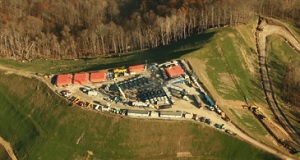The Virginia Outdoors Foundation (VOF) is an important state public agency that has taken part in conserving land in the Commonwealth since 1966. Today, VOF is the largest easement holder in Virginia, and PEC is proud to have partnered with them over the decades. Over the past two years, however, VOF reviewed and approved a number of new easements permit oil and gas drilling—including the potential for hydraulic fracturing (a.k.a. “fracking”)—in areas that have little to no history of energy extraction.
Clean Water
Water flows through all of our land. To keep it plentiful and safe for drinking, swimming and fishing, we need clean air, expansive forests, responsible farms, wooded stream banks, and communities and individuals who make choices to avoid pollution.
Spout Run Watershed Gets Some T.L.C.
Clarke County’s Spout Run watershed is comprised of 14 miles of perennial streams, many of which are spring-fed. So, Spout Run has the potential to provide clean water and support a large variety of wildlife species. Yet, the streams are considered unhealthy due to the levels of nutrients and sediment from fertilizers, livestock, and other human-related activities. For this reason, the Spout Run watershed is on Virginia’s State Impaired Waters List. This is bad news not only for the wildlife and people living around the watershed, but also for those downstream—including the Chesapeake Bay.
Looking Beyond Property Lines to Restore the Thumb Run Watershed
PEC’s Sustainable Habitat Program Manager, James Barnes, often works with landowners in the Piedmont on a one-on-one basis—helping them find ways (and funding) to improve their properties to restore wildlife habitat and water quality. This conservation work is important, and Barnes has worked with many excited landowners. He’s realized, however, that to make a lasting difference in habitat resoration in the Piedmont, landowners will need to start looking past their property lines.
Healthy, Safer Families, and Communities
Arsenic and rocket fuel in our water. Gender-altering hormones and medications in our rivers and streams. PCBs, dioxins and pesticides in breast milk. Lead in children’s toys and women’s lipstick. Hazardous ingredients in air fresheners, development disrupting chemicals in plastic baby bottles and dangerous fumes from vinyl shower curtains. Our world is awash in chemicals and pollutants that pose health risks to our families, our communities and our environment.
What is the Connection Between My Home and My Drinking Water?
Although your property may not have a stream or pond on it, all land is a part of a watershed and has some effect on the condition of waterways. Land and water are intricately connected by the natural water cycle.
Riparian Buffers – The Very Best Protection
Riparian buffers are the single most effective means of protecting water resources. Streams guarded by a healthy forested riparian buffer run far cleaner and cooler and are more stable than a stream without any kind of buffer.
Goose Creek Watershed Study
In early 2002, the Center for Watershed Protection, Goose Creek Association and the Piedmont Environmental Council embarked on a three-phase project to study the Goose Creek Watershed.
Water Quality and Land Use
Streams and rivers are likely to be healthy when at least 91% of the ground in their watershed remains permeable, allowing soil and plants to filter precipitation.
“Poisoned Waters” Documentary on FRONTLINE
FRONTLINE correspondent Hedrick Smith takes an in-depth look at Puget Sound and the Chesapeake Bay, and examines the growing number of hazards to human health and our nation’s waterways.
Both PEC and partner group, the Coalition for Smarter Growth (CSG), were interviewed for the piece. We stressed that poor land use decisions and sprawling development pose the primary threat to the Bay’s water quality.
Limestone Geology and Sinkholes
Limestone geology, also known as Karst, is quite prevalent in the eastern United States. Limestone often dissolves in water, creating voids where groundwater flows like an underground river –gnawing away rock over the eons.
The natural wearing away of limestone over the millenia creates fantastic caves, unique ecosystems and touristic wonders (think Luray Caverns). However, in developed areas, human activities and new development can accelerate the natural pace of erosion–causing sinkholes, threatening buildings and roads, and contaminating groundwater.

